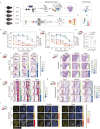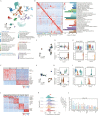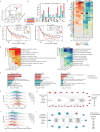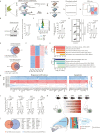Single-cell transcriptomic atlas of mouse cochlear aging
- PMID: 36933008
- PMCID: PMC10098046
- DOI: 10.1093/procel/pwac058
Single-cell transcriptomic atlas of mouse cochlear aging
Abstract
Progressive functional deterioration in the cochlea is associated with age-related hearing loss (ARHL). However, the cellular and molecular basis underlying cochlear aging remains largely unknown. Here, we established a dynamic single-cell transcriptomic landscape of mouse cochlear aging, in which we characterized aging-associated transcriptomic changes in 27 different cochlear cell types across five different time points. Overall, our analysis pinpoints loss of proteostasis and elevated apoptosis as the hallmark features of cochlear aging, highlights unexpected age-related transcriptional fluctuations in intermediate cells localized in the stria vascularis (SV) and demonstrates that upregulation of endoplasmic reticulum (ER) chaperon protein HSP90AA1 mitigates ER stress-induced damages associated with aging. Our work suggests that targeting unfolded protein response pathways may help alleviate aging-related SV atrophy and hence delay the progression of ARHL.
Keywords: aging; cochlea; mouse; single-cell transcriptomic atlas.
©The Author(s) 2022. Published by Oxford University Press on behalf of Higher Education Press.
Conflict of interest statement
The authors declared no competing interests.
Figures






References
-
- Abubacker S, Dorosz SG, Ponjevic Det al. . Full-length recombinant human proteoglycan 4 interacts with hyaluronan to provide cartilage boundary lubrication. Ann Biomed Eng 2016;44:1128–1137. - PubMed
Publication types
MeSH terms
Grants and funding
- 2020YFA0804000/National Key Research and Development Program of China
- XDA16000000/Strategic Priority Research Program of the Chinese Academy of Sciences
- 81921006/National Natural Science Foundation of China
- Z190019/Program of the Beijing Natural Science Foundation
- KFZD-SW-221/Key Research Program of the Chinese Academy of Sciences
- GJTD-2019-06/K. C. Wong Education Foundation
- 2021078/Youth Innovation Promotion Association of CAS
- YESS20200012/Young Elite Scientists Sponsorship Program
- 2021-1045/Tencent Foundation
- CAS-WX2021SF-0301/Informatization Plan of Chinese Academy of Sciences
- 11000022T000000461062/Pilot Project for Public Welfare Development and Reform of Beijing-affiliated Medical Research Institutes
- BE2019711/Natural Science Foundation from Jiangsu Province
- JCYJ20190814093401920/Shenzhen Fundamental Research Program
- SKLGE-2109/Fudan University
- 2021078/Youth Innovation Promotion Association of the Chinese Academy of Sciences
LinkOut - more resources
Full Text Sources
Research Materials
Miscellaneous

